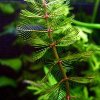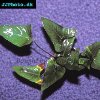Essential Lighting Types for Healthy Aquarium Plants
Quick links - Answers
Overview
One of the ongoing debates among aquarists is about the “right lighting for a planted aquarium.” The truth is, there’s no one-size-fits-all answer. However, it’s well-established that fish thrive in a planted tank; they display more vibrant colors and feel more secure than in an unplanted setup. Therefore, investing in proper lighting to ensure your plants grow well is definitely worthwhile.
Introduction
Before addressing the original question, let’s first explore why plants require lighting in the first place. Plants grow through a process known as photosynthesis, which, although complex, can be explained in simpler terms.
Photosynthesis is the method by which plants convert carbon dioxide and water into glucose and oxygen, the building blocks of plant cells. In nature, the process is represented by the equation:
6CO2 + 6H2O + sunlight = C6H12O6 + 6O2
This equation may seem complex, but in essence, it means that during daylight, plants absorb CO2 produced by fish respiration, along with water, to create oxygen and glucose, which fuel their growth. At night, the process reverses; plants take in oxygen and release CO2. This is why many aquarists turn off their CO2 systems at night to prevent excess CO2 from depleting the oxygen levels in the water, which could harm both fish and plants.
Since natural sunlight isn’t feasible in an aquarium, artificial light must be used to facilitate photosynthesis. Strong lighting is generally recommended for plant growth, but it’s important to note that plants are divided into three basic groups based on their lighting needs: low, medium, and high light requirements. When purchasing aquarium plants, information on their specific lighting needs should be provided.
For non-planted tanks, the lighting provided with an aquarium is typically sufficient, as its main purpose is to enhance the appearance of the fish. However, when plants are introduced, more powerful lighting units are often necessary. Many aquarium manufacturers now recognize the need for better lighting systems and include them as standard in newer setups.
Most planted tank enthusiasts agree that the general rule for lighting is 2-3 watts per gallon (4.55 liters, 1.20 US gallons).
While tubes and bulbs are often rated by wattage, other factors should also be considered when choosing the best lighting system for your aquarium.
Wattage
The wattage rating of the tubes or bulbs you purchase varies based on their size. This is especially true for tubes, where higher wattage typically means a longer tube. For example, an 18-watt tube is usually 60 cm (23.62 inches) long, while a 54-watt tube measures around 121-122 cm (approximately 48 inches).
Wattage indicates the amount of electrical power the light consumes. Different lighting systems may produce varying levels of light output for the same wattage, with well-known brands generally offering higher quality lighting at a slightly higher cost.
Keep in mind that if your lighting setup includes four 54-watt tubes, the total power consumption will be 4 x 54 watts, equaling 216 watts. Therefore, more powerful units will have higher running costs compared to smaller units.
Lumens
Lumens measure the total amount of light a bulb or tube emits. This information used to be prominently displayed on packaging, but it's now harder to find when purchasing lighting. A bulb with a high lumen rating will appear very bright to the human eye. However, our eyes are most sensitive to light in the green spectrum, which isn't the most beneficial for plants. Plants thrive on light in the red and blue spectrums, so a high lumen rating may make the tank look bright, but it doesn't necessarily mean your plants are getting the light they need.
Kelvin Rating
The Kelvin rating measures the color spectrum that a bulb or tube emphasizes. Marine lighting units often have a high Kelvin rating because corals and macroalgae require a lot of blue light for growth. In freshwater setups, plants benefit more from light in the red spectrum, so the Kelvin rating tends to be lower as the spectrum shifts from blue to red.
Originally, aquariums were equipped with incandescent bulbs, which were adequate for viewing fish but not much else. Over time, fluorescent lighting became the norm, offering aquarium owners more options. Daylight tubes were introduced for bright lighting, plant grow tubes for planted aquariums, and actinic tubes for marine tanks.
Advancements led to the development of T8 light tubes, which produce more light than standard tubes of the same size, and later T5 tubes, which are even more efficient.
These lighting units work well for standard-depth tanks. However, as tank designs have become deeper, some aquarists are now using suspended metal halide units that provide light capable of penetrating greater depths.
When selecting lighting, it's important to choose a unit that delivers the right color spectrum for plant growth. A bright light may not be effective if it lacks sufficient red spectrum light. It's generally recommended to use tubes with a Kelvin rating below 10,000K, while marine tubes often have a rating around 20,000K for the blue spectrum.
Consider both the depth and length of your tank when choosing a lighting unit.
The duration of lighting is also crucial. Most planted aquariums benefit from 10-12 hours of light per day. However, this isn't a one-size-fits-all rule, as each aquarium has unique requirements. What works in one tank may not be suitable for another.
Excessive lighting can promote unwanted algae growth, which detracts from the appearance of a well-maintained tank.
Remember, plants also need nutrients in the water to thrive.
Nutrients + Light = Algae
To control algae growth, one of the most effective methods is to minimize the amount of unused nutrients in the water. You can also try reducing the duration of your lighting by an hour, which can significantly impact algae formation. Another tried-and-true technique is to turn off the lights for an hour in the middle of the day. This break disrupts the algae's growth cycle and can eventually prevent it from appearing altogether.
As mentioned earlier, different plants have varying lighting needs. It's important to research the plants you plan to add and choose ones with similar requirements. There's no need to invest in a high-powered light unit if your plants thrive in low light. A quick online search can provide the information you need, but here's a general guide:
- Low lighting - Cryptocorynes, Java Fern, Java Moss
- Medium lighting - Sagittaria, Echinodorus
- High lighting - Cabomba, Salvinia, Lemma
If you find that your lighting is too intense for some plants, try adding floating plants like Salvinia to reduce the light exposure. Another option is to plant lower-light species in the shadow of larger plants.
Now, let's explore some of the lighting units that are currently available or have been popular in the past:
Incandescent Lighting
Incandescent lighting was the original choice for aquarium illumination, predating all modern options. Back in the early days of fishkeeping, it was considered a great way to showcase the tank and its inhabitants. However, it was not very economical; it consumed a lot of power and generated significant heat, which led to increased water evaporation. I remember using a 15-watt bulb in an 11-gallon (about 50 liters or 13 US gallons) tank, and to my surprise, the Java ferns and Amazon swords thrived under it. It was only later that I discovered these plants are actually suited for low lighting. The color produced by these bulbs was often distorted due to their low Kelvin rating.
Halogen bulbs are now more commonly used for smaller setups. While they represent an improvement, they are still inefficient in terms of power consumption. The light they produce is brighter but still lacks the true color quality provided by other lighting types.
Fluorescent Lighting
Fluorescent lighting marked a significant advancement in aquarium illumination. It is much more energy-efficient compared to incandescent lighting and offers a wide range of wattages and Kelvin ratings. This innovation greatly expanded the variety of plants that could thrive in a planted tank. Early fluorescent units typically featured two tubes powered by separate ballasts, which often required cooling fans due to the heat they generated during operation.
The evolution of fluorescent lighting introduced slimmer tubes that provided the same amount of light while using less wattage. This change reduced running costs and allowed for the inclusion of up to four tubes in some units. These newer tubes, known as T8s, were soon followed by T5s. The shift to electronic ballasts in modern units, often built-in, improved efficiency and performance, making fluorescent lighting an excellent choice for a wide range of plants.
Metal Halide Lighting
For deeper tanks, Metal Halide lighting is often necessary to ensure sufficient light reaches the bottom for foreground plants. These units are typically suspended above the aquarium and are known for their high power output, with some using bulbs up to 800 watts. While effective, they are expensive to operate. One advantage of Metal Halide lighting is that it casts natural-looking shadows and ripples through the tank, mimicking sunlight in nature.
Regardless of the lighting type you choose, keep the following considerations in mind:
- Bulbs or tubes lose effectiveness over time and should be replaced every 6-9 months to maintain optimal performance.
- When purchasing a complete tank setup, ensure the included lighting is adequate for a planted tank; you may need to upgrade.
- Avoid excessive lighting, as overly intense light can scorch and kill plants, especially floating ones.
- Always address any issues with lighting units immediately. Water and electricity do not mix, so replace faulty units without delay.







